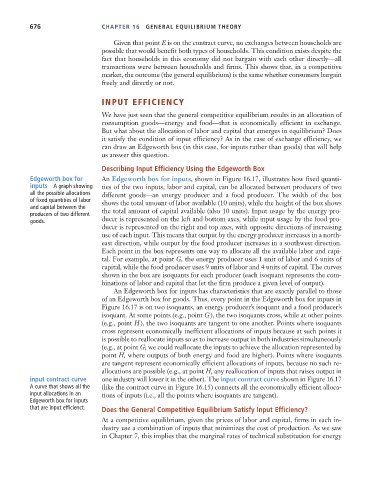Page 702 - Microeconomics, Fourth Edition
P. 702
c16GeneralEquilibriumTheory.qxd 8/16/10 9:14 PM Page 676
676 CHAPTER 16 GENERAL EQUILIBRIUM THEORY
Given that point E is on the contract curve, no exchanges between households are
possible that would benefit both types of households. This condition exists despite the
fact that households in this economy did not bargain with each other directly—all
transactions were between households and firms. This shows that, in a competitive
market, the outcome (the general equilibrium) is the same whether consumers bargain
freely and directly or not.
INPUT EFFICIENCY
We have just seen that the general competitive equilibrium results in an allocation of
consumption goods—energy and food—that is economically efficient in exchange.
But what about the allocation of labor and capital that emerges in equilibrium? Does
it satisfy the condition of input efficiency? As in the case of exchange efficiency, we
can draw an Edgeworth box (in this case, for inputs rather than goods) that will help
us answer this question.
Describing Input Efficiency Using the Edgeworth Box
Edgeworth box for An Edgeworth box for inputs, shown in Figure 16.17, illustrates how fixed quanti-
inputs A graph showing ties of the two inputs, labor and capital, can be allocated between producers of two
all the possible allocations different goods—an energy producer and a food producer. The width of the box
of fixed quantities of labor shows the total amount of labor available (10 units), while the height of the box shows
and capital between the the total amount of capital available (also 10 units). Input usage by the energy pro-
producers of two different
goods. ducer is represented on the left and bottom axes, while input usage by the food pro-
ducer is represented on the right and top axes, with opposite directions of increasing
use of each input. This means that output by the energy producer increases in a north-
east direction, while output by the food producer increases in a southwest direction.
Each point in the box represents one way to allocate all the available labor and capi-
tal. For example, at point G, the energy producer uses 1 unit of labor and 6 units of
capital, while the food producer uses 9 units of labor and 4 units of capital. The curves
shown in the box are isoquants for each producer (each isoquant represents the com-
binations of labor and capital that let the firm produce a given level of output).
An Edgeworth box for inputs has characteristics that are exactly parallel to those
of an Edgeworth box for goods. Thus, every point in the Edgeworth box for inputs in
Figure 16.17 is on two isoquants, an energy producer’s isoquant and a food producer’s
isoquant. At some points (e.g., point G ), the two isoquants cross, while at other points
(e.g., point H ), the two isoquants are tangent to one another. Points where isoquants
cross represent economically inefficient allocations of inputs because at such points it
is possible to reallocate inputs so as to increase output in both industries simultaneously
(e.g., at point G; we could reallocate the inputs to achieve the allocation represented by
point H, where outputs of both energy and food are higher). Points where isoquants
are tangent represent economically efficient allocations of inputs, because no such re-
allocations are possible (e.g., at point H, any reallocation of inputs that raises output in
input contract curve one industry will lower it in the other). The input contract curve shown in Figure 16.17
A curve that shows all the (like the contract curve in Figure 16.15) connects all the economically efficient alloca-
input allocations in an tions of inputs (i.e., all the points where isoquants are tangent).
Edgeworth box for inputs
that are input efficienct. Does the General Competitive Equilibrium Satisfy Input Efficiency?
At a competitive equilibrium, given the prices of labor and capital, firms in each in-
dustry use a combination of inputs that minimizes the cost of production. As we saw
in Chapter 7, this implies that the marginal rates of technical substitution for energy

